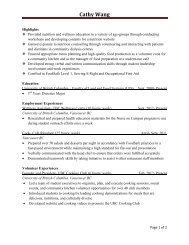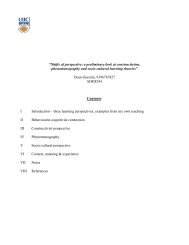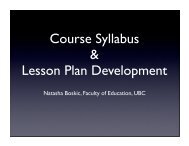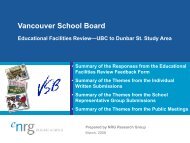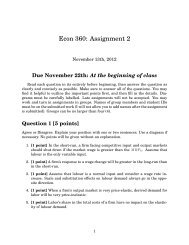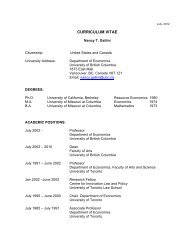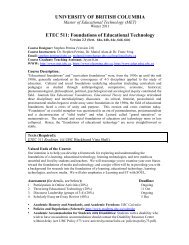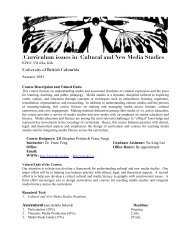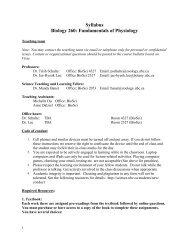Final Lab Exam - UBC Blogs
Final Lab Exam - UBC Blogs
Final Lab Exam - UBC Blogs
You also want an ePaper? Increase the reach of your titles
YUMPU automatically turns print PDFs into web optimized ePapers that Google loves.
STATION #3 – Thursday - 24 TOTALSLIDE A: CLADE Coniferophytes (or conifers) 1Make a quick sketch of Slide A. <strong>Lab</strong>el with the following terms (not all apply; wrong answers will bepenalized): cotyledon, endosperm, megagametophyte, microgametophyte, root apical meristem, root cap.Indicate the ploidy of labeled stuctures. Deduct 1 mark for each term incorrectly applied. No credit for ploidy ifstructure not correctly identified.SLIDE B: CLADE Angiosperm 1Name each structure and indicate its ploidy:1. cotyledon 1 2N 1 4. embryo = germ 1 2N 12. shoot apex 1 2N 1 5. ovary wall (pericarp) and seed coat= bran 1 2N 13. radicle (or root apex) 1 2N 1 6. endosperm 1 3N (1 bonus)Is this structure a seed or fruit? Explain your answer.It is a fruit (developed from ovary). The ovary wall is fused to the seed coat. Thisfruit contains one seed. 1Contrast the storage material in A and B (give at least one major difference).One good answer - 2- Storage material in A is haploid, while that of B has a higher ploidy- Storage material in A is megagametophyte while that of B is endosperm (the product offusion of sperm nucleus with polar nuclei
STATION #4 – Thursday - 23 TOTALPART A - <strong>Exam</strong>ine the flower of Plant A. A drawing of a longitudinal section through a flower is taped to thebench. In the spaces below, write the appropriate labels for each of the numbers on the diagram and theinformation requested.Name the Structure:What is the function of each structure?1. Stigma 1 Receptive site for pollen 12. Sepal 1 Attracts pollinator (also can protect flower bud) 13. Petal 1 Attracts pollinator 14. Hypanthium 1 - fills with nectar (reward for pollinator) 1, accept other good answers5. Ovary 1 Becomes fruit – important in ovule/seed protection as well as seeddispersal 16. Ovule 1 Becomes seed 17. Style 1 Tissue through which pollen tube grows – elevates the stigma forpollen reception 18. Anther (or stamen) 1 Produces pollen 1Fill in each blanks with the term that applies to the flower. Choose from: actinomorphic, axile, epigynous,hypogynous, inferior, parietal, perigynous, superior, zygomorphic. (Use of incorrect terms will be penalized)Flower type: epigynous 1Ovary position: superior 1Placentation: axile 1Floral symmetry: actinomorphic 1PART B <strong>Exam</strong>ine the sample (do not eat).Circle the terms that apply to the specimen B (wrong answers will be penalized):Deduct 1 mark for each term incorrectly circled.achene, accessory fruit, berry, 1 drupe, grain, hesperidium, legume, multiple fruit, pepo, 1 pomeDid the ovary of the flower that produced this fruit contain more than one ovule? Explain your answerYes, you can tell because there are many seeds…..each came from one ovule. 1
STATION #5 – Thursday - 23 TOTALCladePLANT A PLANT B PLANT CLeptosporangiate Equisetaceae 1 Lycoodiaceae 1fern 1Circle the slide #that corresponds 1, 1 2, or none 1, 2, or none1 1, 2, 1 or nonewith each plant.Heterosporous or Homosporous 1 Homosporous 1 Homosporous 1HomosporousEusporangiate of Leptosporangiate 1 Eusporangiate 1 Eusporangiate 1LeptosporangiatePrimary xylem Mesarch 1 Endarch 1 Exarch 1development (stem)Make a quick sketch of Slide 1. <strong>Lab</strong>el the position of the metaxylem, protoxylem, phloem and endodermis.Circle the terms that apply to this organism (incorrect answers will be penalized.):Deduct 1 mark for each term incorrectly circled.amphiphloic siphonostele, 1 protostele, ectophloic siphonostele, dictyostele, 1 plectostele, atactostelePART II:Based on what you know and/or see, contrast the vegetative* features of Organism A and Organism B. Give atleast 2 differences not based on information in the table above.*Note: vegetative refers to features that are not associated with reproduction (e.g. leaf structure etc).There are a number of possible answers for this question. Give credit for good answers. <strong>Exam</strong>ples are given below.DIFFERENCES 2 marks (one for each answer)- A has compound leaves, B has simple leaves- B has fused leaves, A does not- A’s leaves are the main photosynthetic organ, B’s are stems- Leaves of B’s are in whorls, leaves of A are not (spiral)- B has silicated cell walls, A doesn’t- B’s stem has a system of canals, A’s does not




